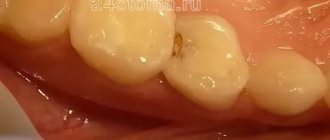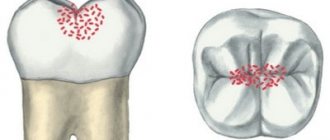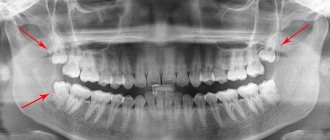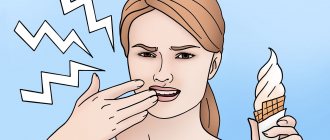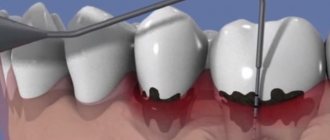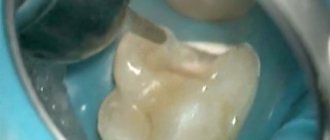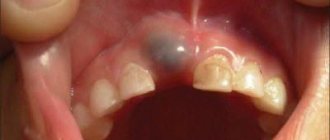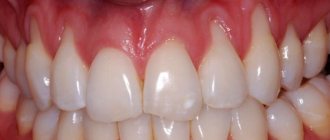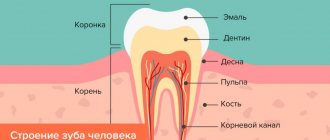Dental caries is a disease that destroys the structure of the tooth and causes it to fall out. Every person can face this problem, regardless of their gender and age.
Dental caries occurs due to the adverse effects of bacteria on tooth enamel, which leads to its destruction and damage to the deeper layers of the tooth. Treatment for this problem will take quite a long time and therefore it is worth preventing it, so that you don’t have to sit in dental offices for months.
How does caries develop?
Caries is a pathological process that destroys the hard tissues of the tooth. By its nature, it is sluggish and usually occurs under the influence of negative environmental factors or internal problems of the body. Bacteria in the oral cavity produce organic acid that corrodes the enamel, which leads to the development of pathology. The more bacteria, the more acid and, accordingly, the greater the damage.
In this article
- How does caries develop?
- Is it possible to remove caries at home?
- How to remove caries at home using folk remedies?
- What is effective against caries at home?
- The influence of dietary habits on caries
- Good immunity reduces the risk of developing caries
- How to brush your teeth and how to rinse your mouth to prevent caries
- Don't forget about professional hygiene
- Conclusion
Often the disease begins under the surface of the tooth, so in the absence of pronounced symptoms, it is not always possible to notice it at an early stage without the help of a doctor. Early caries looks like a white dot on the enamel surface. At the same time, most people imagine carise as a huge hole in the tooth. Therefore, often a person with early caries does not suspect that a pathological process has begun in his tooth.
A person can know that there is caries in a tooth when the carious cavity expands to the upper part of the tooth or when acute toothache signals this. The most correct and safe option for any dental problems is to contact a dental clinic as quickly as possible. But if for some reason this is not possible, people are looking for a way to cure tooth decay on their own.
Timely visits to the dentist are the key to the absence of caries
Even a person who has completely healthy teeth should go to the dentist at least once every six months. Since it is impossible to identify minor pathological processes on your own, without medical supervision the problem goes further.
Regular dental examinations will help prevent tooth decay because:
- the doctor will give an objective assessment of the condition of the oral cavity;
- The dentist will always advise you on how to brush your teeth, what toothpaste and brush to choose;
- the doctor will notice minor problems and eliminate them, preventing further development of the pathology.
Not knowing how to prevent tooth decay can lead to serious problems, including financial ones. To prevent them, you need to contact the dentists of the Dent Prestige clinic in a timely manner and go for all scheduled examinations. Working closely with your dentist will help a person protect their teeth from caries. Preserve their beauty and health.
Is it possible to remove caries at home?
This question may arise in the following cases:
- a person is afraid of dentists and is willing to risk his dental health rather than go to the doctor;
- there is no opportunity to visit a doctor for objective reasons (for example, on a long trip or when there is no good clinic nearby);
- a small child resists dental treatment in the dentist's office;
- no money for dental treatment.
In most cases, it is impossible to get rid of caries at home.
But there are medicinal methods that help strengthen the enamel and stop the pathological process at an early stage, when caries looks like a white speck on the enamel. To do this, use gels that restore enamel and means for its remineralization.
You can use these anti-caries remedies at home, but a dentist must prescribe them and monitor the process.
Classification of dental disease
Depending on the depth of the lesion, there are the following types of disease:
- Spot. At this stage, a light or dark spot appears on the surface of the enamel, while its structure remains unchanged. It occurs due to demineralization of the enamel. During this period, treatment is the simplest, fastest and most painless.
- Surface. To understand how initial superficial caries in adults is treated, you need to understand its essence. At this stage, destruction occurs within the enamel layer and does not affect the dentin. The patient may experience pain when eating cold, hot and sweet foods. To combat the disease, the stain is polished, after which the tooth is remineralized.
- Average. This type of disease affects the surface layer of dentin. A person may experience constant aching or intermittent pain. Do you want to know how to treat average caries in the video? To heal, the damaged part of the tooth is removed and a filling is installed in its place.
- Deep. In this case, tissue damage is most severe. Interested in the question of how to treat deep advanced caries? To successfully get rid of such a complex disease, you need to completely remove the damaged area of the tooth by installing a filling. Untimely treatment can lead to serious complications associated with pulp inflammation.
To see how dental caries is treated and photos of the stages of the disease, it is enough to study the principles that modern dental clinics follow. The algorithm and complexity of the procedures performed depend on how advanced the problem you have is.
According to Black's classification, there are the following types of caries:
- Fissure. Do you doubt whether fissure caries should be treated? This type of disease is characterized by the occurrence of damage that occurs in the fissures - the natural recesses of the tooth. Timely consultation with a doctor will help prevent the further development of this pathological process.
- Approximal. The disease affects the contact surfaces of the canines, incisors and molars.
If you want to know how to treat decay on your front teeth while maintaining their integrity and attractiveness, seek help from an experienced dentist.
- Cervical. The process affects the base of the teeth near the gums. Would you like to know how root and cervical caries on the front teeth are treated? An experienced dentist decides how to treat caries near the gums. To restore the original functions of the cervix and its aesthetic appearance, the help of a professional doctor is necessary.
How to remove caries at home using folk remedies?
In addition to the medicinal approach, there are a lot of popular recommendations on how to get rid of caries at home. Here are a few recipes that traditional medicine offers:
- Rinse your mouth with sage infusion.
One tablespoon is poured with boiling water, the broth is left for about an hour, and then a cotton swab is moistened in the resulting infusion and applied to the affected tooth. After this, you need to rinse your teeth and mouth with sage. Dentists note that sage is indeed a natural antiseptic and can prevent the growth of bacteria. But this remedy does not help cure dental caries at home; it can only temporarily slow down the process or serve as a preventive measure for caries.
- Apply fir oil to the tooth.
Another popular recommendation is to apply a cotton swab with fir oil to the sore tooth. You will not be able to remove caries with this remedy on your own, but it can temporarily provide a good analgesic effect. You should make an appointment with a doctor as soon as possible, because pain in the teeth may indicate complicated caries or pulpitis.
- Garlic.
There are many folk tips for home treatment of caries using garlic. It is recommended to apply it to the tooth, lean it against the cheek on the side of the diseased tooth, and soak the enamel with juice. And although garlic’s ability to destroy microbes is beyond doubt, it is powerless in the fight against tooth decay. At best, it will partially relieve pain, but it certainly will not help cure deep caries.
- Onion peel.
To treat caries at home, it is suggested to prepare a decoction of onion peels, leave it for several hours and use it as a mouth rinse. The infusion has an antiseptic effect and slightly dulls the pain. There are dozens of other folk recipes that suggest rinsing your mouth, applying something to tooth enamel, or rubbing it into your gums.
- Self-medication is dangerous and unprofitable
It is important to treat any folk remedies critically and remember that their use not only does not guarantee recovery, but can sometimes be dangerous. For example, tinctures for rinsing with alcohol cause damage to the mucous membrane, ulcers and tissue erosion.
You must understand that the development of caries in most cases can be stopped only by removing damaged tooth tissue and filling the cavity. No herbal infusion can cope with this task.
Trying to cure caries at home, a person triggers the pathological process to such an extent that serious complications can arise, and caries spreads to the soft tissues of the tooth. And then, in any case, it will not be possible to avoid visiting the dentist, only the treatment process will be longer, more painful and will require significant financial costs.
Children and pregnant women: features of their treatment
Methods of dealing with dental problems in a child depend on his age. When looking for an answer to the question of how caries of baby teeth is treated, you need to take into account the degree of neglect of the disease. Delivering a lot of unpleasant experiences to a small patient, it affects the growth and development of permanent (molar) teeth. To prevent them from being damaged during teething, you should not turn a blind eye to the existing carious cavities in your child’s mouth. How to treat bottle caries is decided directly by the dentist himself, in consultation with the baby’s parents.
Many expectant mothers are concerned about the question of whether caries can be treated during pregnancy. The likely consequences and negative effects of painkillers on the developing fetus frighten most pregnant women. Exposure to an even greater risk of developing this disease, young mothers should treat their health with increased attention. Beginning damage to tooth enamel should be stopped immediately to prevent possible complications in the form of pulpitis or the development of a cyst.
The influence of dietary habits on caries
The destruction of the enamel structure is facilitated by the acid secreted by bacteria. It is formed in large quantities when consuming carbohydrate foods. Therefore, to prevent caries, it is necessary to limit the consumption of sweets and sugar, and after eating sweet foods, be sure to rinse your mouth.
Caries develops faster when the enamel becomes thinner. In order for teeth to be strong and less susceptible to decay, the body must receive sufficient amounts of vitamins and microelements. They can be taken as a multivitamin as prescribed by your doctor, but it is best to take them through food. To do this, the diet must be varied and balanced, it must contain dairy products, fish, cheese, and fresh herbs.
It is useful to eat solid vegetables and fruits (carrots, apples). They mechanically clean the enamel from plaque and stimulate blood flow in the gums. Avoid eating foods and drinks that are too hot or too cold. Due to temperature changes, microscopic cracks form on the enamel, which contributes to the development of caries.
What you shouldn’t drink to protect yourself from tooth decay
Often drinks can not only bring pleasure, but also destroy teeth. The destruction of enamel and stronger, deeper tooth structures is carried out in the process of interaction with the following liquids:
- sweet, highly carbonated drinks;
- sweet tea and coffee;
- very hot or cold drinks.
Of course, if you occasionally drink soda or very sweet tea, there will be no significant harm, but if we are talking about regular consumption of such drinks, your teeth will begin to ache and the enamel will be destroyed.
To prevent the occurrence of dental caries, a person should not often drink drinks from these categories and then the teeth will be healthier and stronger.
Good immunity reduces the risk of developing caries
The bacteria that cause tooth decay are part of the normal microflora of the oral cavity. But with weakened immunity and other accompanying factors, they can cause caries. At home, everyone can prevent this dental disease by strengthening the immune system. This is facilitated by hardening, reducing stress levels, quality sleep at night, proper nutrition, giving up bad habits, and maintaining a normal weight.
The fewer factors that weaken the immune system, the lower the risk of dental caries.
Infiltration method
Icon infiltration technology was invented at the Celtic University of Germany. This method of microinvasive treatment of caries refers to chemical-mechanical treatment, which completely eliminates tooth preparation - drilling, and is used only in the treatment of initial caries, initial carious lesions after using braces, as well as caries in the spot stage. The principle of operation of the method is to apply a special gel to the surface of the affected area of the tooth, which splits the enamel, after which the carious lesion is dried with 99% ethyl alcohol in combination with an air stream and impregnated with a polymer resin. The procedure protocol is clearly depicted in the figure below.
The positive aspects of this technology can be considered painless and quick (the procedure takes 15–20 minutes) removal of exclusively the affected part of the tooth. However, the method is applicable only on the smooth surface of the teeth or between them. Also, the shape of the “hole” should be ideal - with smooth edges and a wide entrance. International studies have confirmed the effectiveness of the infiltration method, which has made it possible to stop the development of caries for many years in both adult patients and children.
How to brush your teeth and how to rinse your mouth to prevent caries
Everyone can take care of their dental and oral health without leaving home. To do this, you must follow the rules of hygiene:
- Brush your teeth twice a day using the correct technique for at least two to three minutes.
- Use fluoride toothpaste (if recommended by your dentist).
- After brushing your teeth, be sure to use dental floss to remove food debris and plaque from the interdental spaces.
- Using an irrigator helps to achieve the maximum degree of cleanliness. This device creates a powerful stream of water that removes dirt from areas of the mouth where a toothbrush cannot reach.
- It is important to brush not only your teeth, but your tongue and the inside of your cheeks. Plaque also accumulates on them and bacteria that cause caries multiply.
- Use special rinses after cleaning. They have an antimicrobial effect, preventing the proliferation of pathogenic microorganisms in the oral cavity.
Laser dental treatment without a drill
Treatment of caries with a laser, in other words, laser fluorescence, as well as the above methods, implies the treatment of caries without drilling in the sense in which we are accustomed to understanding drilling and the associated discomfort.
Why does unpleasant pain occur while the drill is working? The fact is that intense heating and friction occurs between the dental drill and enamel, dentin. And to these sensations is added vibration that spreads to the dental tissues. During laser treatment, tissue heating does not occur due to the low radiation power. In addition, laser devices are 20 times quieter than a drill! In this case, the main thing is not to accidentally fall asleep in the dentist’s office. It is not without reason that this method is recommended not only for people with increased sensitivity to pain and sounds, but also for those most sensitive to the perception of external stimuli - pregnant women and children. In addition, the procedure for laser treatment of caries is absolutely sterile - the tip of the installation does not come into contact with the teeth. The laser performs cavity preparation by selectively affecting caries, or, more precisely, only tissue infected with caries. The impact completely suppresses the growth of carious bacteria and eliminates the risk of secondary caries. At the same time, the laser method does not harm healthy teeth, and also does not lead to microcracks in the enamel. And the time spent on treating caries is reduced by about 40% compared to traditional treatment - there is no need to change attachments, and when treating superficial caries, there is no need to use anesthesia. Today, dentistry uses lasers not only as a method of treating caries, but also as a diagnostic method. The second is a significant advantage compared to X-ray diagnostics, since in the case of laser “checking” there is no radiation.
Disadvantages of treating caries without drilling teeth
- high cost of laser installation
- high demands on specialists working with lasers
- treatment requires the use of protective dark glasses by both the patient and the doctor
- glasses with tinted lenses can distort the reality and reduce the clarity of vision
- in some cases, soft tissue damage caused by lasers heals slowly and poorly
- there is also a possibility that the laser will be reflected from metal objects in the dentist's office, if they are not removed, and cause a fire
Don't forget about professional hygiene
No matter how carefully you take care of your oral cavity at home, you need to undergo a professional cleaning procedure at the dentist twice a year. In a clinical setting, you can effectively remove complex dental deposits and restore the normal mineral balance of tooth enamel. If you wear braces, professional cleaning should be done at least three times a year.
Professional oral hygiene and further care at home along with other caries prevention measures will help to reliably protect tooth enamel from destruction.
Clarification of symptoms
It is very important to recognize a carious lesion at the earliest possible stage. To do this, you need to clearly know the symptoms and be observant. Paying attention to your body will help you avoid very serious problems in the future.
White spots on teeth are the first signs of pathology
Symptoms of incipient caries may be as follows.
- Light, gently sloping cavities on the teeth.
- Dark depressions or stains on the enamel or between the teeth.
- Increased sensitivity of an individual tooth or the entire dentition.
- Feeling of toothache, even minor.
- Discomfort when eating food of high or low temperature.
- Sensitivity of enamel to sweet, sour, spicy.
- Painful sensations when biting.
Important! Interdental and some other types of deep caries may not manifest themselves for a long time and remain invisible. The disease is detected only with an x-ray, ultrasound, or when the oral cavity is illuminated with a fluorescent lamp. That is why visiting the dentist twice a year is a guarantee of early detection of carious symptoms and successful treatment of the disease.
Interdental caries
Having identified one or more symptoms of caries, you should immediately make an appointment with a doctor, without waiting until the due date has expired and it is time for the next preventative visit.
At the appointment, the doctor must tell you about the symptoms and point out any signs of destruction found. The dentist examines the oral cavity using instruments to identify tissue softening (light carious spots) or darkening. Depending on the stage of the disease, the doctor will recommend a home treatment algorithm or use one of the clinical methods for eliminating caries.
There is no need to wait until caries completely destroys your teeth; it is better to contact your dentist on time
Dental caries in children
In children, identifying caries is quite simple: first, white or brown spots appear on the teeth, then the teeth begin to react to hot or cold food, and bad breath may appear. All these symptoms indicate the rapid development of the disease. If action is not taken in time, the infection can spread to several teeth at once.
Causes of caries development in children:
- The main cause of childhood caries is poor oral hygiene. The task of parents is to choose the right toothbrush for their child and teach him how to brush his teeth. Many young children are afraid of this harmless procedure, so we can recommend trying to present brushing as a game. It is necessary to accustom a child to brush independently starting from the age of 3 (before this moment, parents should brush the child’s gums and teeth).
- The infection can be transmitted from an adult to a child. As a rule, this happens if you eat with a child with the same spoon or kiss him on the lips, which is often abused by adults who are unable to cope with an overabundance of feelings.
- Genetic characteristics associated with abnormal maternal lifestyle during pregnancy. Teeth form during the first trimester, so if a woman smokes or drinks alcohol, this can affect the baby's dental development.
- Early caries, which appears in children before the age of 2 years, can be caused by poor mineralization of baby teeth.
- Various chronic diseases can also cause cavities.
- In infants, bottle tooth decay often occurs when the child eats food before bed. After eating, food residues remain on the teeth, and parents, instead of brushing the child’s teeth, put him to bed.
Homeopathic treatment
Classical homeopathy offers several remedies for the treatment of dental diseases, including caries. Followers of traditional medicine doubt whether it is possible to restore tooth enamel with homeopathic remedies. Of course, such drugs will not fill the defect, but they can easily cope with inflammation and pain, as well as suppress the growth of bacteria. Thus, they stop the pathological process of tooth decay.
Homeopathic toothpaste “Belka-K”
The toothpaste contains the following active substances in homeopathic concentrations:
- Silicea - neutralizes the effects of acidic foods, increases the hardness of tooth enamel.
- Calcarea phosphoricum - prevents demineralization of teeth, normalizes calcium metabolism.
- Comfrey - increases the absorption of calcium salts by tooth tissues, stimulates healing processes.
- Sambucus - reduces tooth sensitivity and has an analgesic effect.
- Ratania - eliminates bleeding and inflammation of the gums.
- Plantago - restores enamel, returns its whiteness.
- Camphor - has an anti-inflammatory effect.
- Horse chestnut - normalizes blood flow in the gums, eliminates bleeding gums.
- Chamomile - stimulates regenerative processes in gums and dental tissue, has an antibacterial effect.
- Fir oil - removes tartar and plaque, whitens enamel.
Belka-K toothpaste should be used to brush your teeth twice a day for three minutes. The course of treatment is two months.
Remember! Self-treatment of caries is possible only in the earliest stages! In advanced cases, it is imperative to carry out therapy only in a dental office with an experienced doctor.
Why is the Icon method not always used?
The main limitation is the late diagnosis of caries, because treatment with Icon is possible only at the initial stage.
Sometimes doctors offer remineralization therapy to treat white spots and strengthen the enamel. We talk about this method of caries prevention in the article Help your teeth! Do deep fluoridation.
According to clinical studies, the success of treatment with the Icon method (no caries for 5 years) is about 80%. Icon is not used if the integrity of the enamel is damaged, a small cavity has appeared, or the enamel has become thinner due to non-carious lesions. In these cases, it is only possible to use traditional methods of caries treatment.
Icon is the embodiment of every patient’s dream: to come to the dentist, anoint the tooth and leave healthy. Therefore, if the doctor suggests trying Icon, you came to your appointment on time!
Why caries needs to be treated
Because it destroys the tooth. Violating the integrity of the enamel, caries makes the tooth vulnerable to infection and further destruction. As a result, the patient suffers not only severe pain, but also a real chance of losing the tooth. This is possible if treatment is not started in a timely manner. Complications that caries can cause:
- Pulpitis. Inflammation of the dental pulp, which is accompanied by severe pain and the possible development of purulent complications. As a result, the nerve is removed, which significantly shortens the life of the tooth.
- Periodontitis. Inflammation of hard periodontal tissues as a result of the spread of infection.
- Abscess. Consequences of acute periodontitis.
- Cyst. Formed on the root of the tooth or in the tissues of the jaw surrounding it. Often filled with pus.
- Flux. The inflammation spreads to the periosteum, resulting in a purulent abscess that must be opened with an incision. Afterwards, the pus is removed and antibiotic treatment is prescribed.
Prevention
It is not difficult to maintain the health of your teeth; just follow the simple recommendations of specialists. First of all, this concerns daily care. To clean the oral cavity, you should use only high-quality toothbrushes of medium hardness, rinses containing useful additives, threads (floss), irrigators and other devices convenient for home use.
You can examine the jaw yourself; you just need to stand in front of a mirror in a room with good lighting. If you notice any changes in the color or texture of your enamel, you should make an appointment with your doctor as soon as possible. If possible, then after each meal you need to rinse your mouth and clean out food particles between your teeth.
You can also reduce your consumption of flour, sweets and any other junk food. If you do the remineralization procedure at least once a year, the enamel will become much stronger and more resistant to the destructive effects of pathogens. An accessible method of prevention is professional hygiene, for example, using Air Flow technology. During the cold season, you can eat fruits and take vitamin complexes, this helps strengthen the body’s protective properties.
Why wait for caries to win?
In most cases, caries develops over years and begins with the appearance of a white or brownish spot on the tooth. At this stage, only the tooth enamel is destroyed.
The traditional method of treating caries is to install a filling after removing the infected tissue. But in order to replace tissues damaged by caries with a filling that will last for several years, it is necessary to form a cavity of a certain depth.
Along with the infected tissues, the doctor has to remove the part of the tooth that is not damaged by caries. The doctor feels sorry for the tooth, because the treatment turns out to be no less destructive than the disease.
